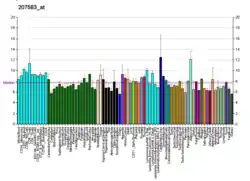ABCD2
ATP-binding cassette sub-family D member 2 is a membrane pump/transporter protein that in humans is encoded by the ABCD2 gene.[5][6]
Function
The protein encoded by this gene is a member of the superfamily of ATP-binding cassette (ABC) transporters. ABC proteins transport various molecules across extra- and intra-cellular membranes. ABC genes are divided into seven distinct subfamilies (ABC1, MDR/TAP, MRP, ALD, OABP, GCN20, White). This protein is a member of the ALD subfamily, which is involved in peroxisomal import of fatty acids and/or fatty acyl-CoAs in the organelle. All known peroxisomal ABC transporters are half transporters which require a partner half transporter molecule to form a functional homodimeric or heterodimeric transporter. The function of this peroxisomal membrane protein is unknown; however this protein is speculated to function as a dimerization partner of ABCD1 and/or other peroxisomal ABC transporters.[6]
Clinical significance
Mutations in this gene have been observed in patients with adrenoleukodystrophy, a severe demyelinating disease. This gene has been identified as a candidate for a modifier gene, accounting for the extreme variation among adrenoleukodystrophy phenotypes. This gene is also a candidate for a complement group of Zellweger syndrome, a genetically heterogeneous disorder of peroxisomal biogenesis.[6]
See also
References
- GRCh38: Ensembl release 89: ENSG00000173208 - Ensembl, May 2017
- GRCm38: Ensembl release 89: ENSMUSG00000055782 - Ensembl, May 2017
- "Human PubMed Reference:". National Center for Biotechnology Information, U.S. National Library of Medicine.
- "Mouse PubMed Reference:". National Center for Biotechnology Information, U.S. National Library of Medicine.
- Lombard-Platet G, Savary S, Sarde CO, Mandel JL, Chimini G (March 1996). "A close relative of the adrenoleukodystrophy (ALD) gene codes for a peroxisomal protein with a specific expression pattern". Proc Natl Acad Sci U S A. 93 (3): 1265–9. doi:10.1073/pnas.93.3.1265. PMC 40068. PMID 8577752.
- "Entrez Gene: ABCD2 ATP-binding cassette, sub-family D (ALD), member 2".
- Mayerhofer PU, Kattenfeld T, Roscher AA, Muntau AC (March 2002). "Two splice variants of human PEX19 exhibit distinct functions in peroxisomal assembly". Biochem. Biophys. Res. Commun. 291 (5): 1180–6. doi:10.1006/bbrc.2002.6568. PMID 11883941.
- Gloeckner CJ, Mayerhofer PU, Landgraf P, Muntau AC, Holzinger A, Gerber JK, Kammerer S, Adamski J, Roscher AA (April 2000). "Human adrenoleukodystrophy protein and related peroxisomal ABC transporters interact with the peroxisomal assembly protein PEX19p". Biochem. Biophys. Res. Commun. 271 (1): 144–50. doi:10.1006/bbrc.2000.2572. PMID 10777694.
Further reading
- Petroni A, Cappa M, Carissimi R, Blasevich M, Uziel G (2007). "Effect of testosterone metabolites on ABC half-transporter relative gene expression in X-linked adrenoleukodystrophy". J. Inherit. Metab. Dis. 30 (5): 828. doi:10.1007/s10545-007-0591-1. hdl:2434/142675. PMID 17602313. S2CID 31900837.
- Weinhofer I, Kunze M, Rampler H, Bookout AL, Forss-Petter S, Berger J (2006). "Liver X receptor alpha interferes with SREBP1c-mediated Abcd2 expression. Novel cross-talk in gene regulation". J. Biol. Chem. 280 (50): 41243–51. doi:10.1074/jbc.M509450200. PMID 16249184.
- Mayerhofer PU, Kattenfeld T, Roscher AA, Muntau AC (2002). "Two splice variants of human PEX19 exhibit distinct functions in peroxisomal assembly". Biochem. Biophys. Res. Commun. 291 (5): 1180–6. doi:10.1006/bbrc.2002.6568. PMID 11883941.
- Gloeckner CJ, Mayerhofer PU, Landgraf P, Muntau AC, Holzinger A, Gerber JK, Kammerer S, Adamski J, Roscher AA (2000). "Human adrenoleukodystrophy protein and related peroxisomal ABC transporters interact with the peroxisomal assembly protein PEX19p". Biochem. Biophys. Res. Commun. 271 (1): 144–50. doi:10.1006/bbrc.2000.2572. PMID 10777694.
- Sacksteder KA, Jones JM, South ST, Li X, Liu Y, Gould SJ (2000). "PEX19 binds multiple peroxisomal membrane proteins, is predominantly cytoplasmic, and is required for peroxisome membrane synthesis". J. Cell Biol. 148 (5): 931–44. doi:10.1083/jcb.148.5.931. PMC 2174547. PMID 10704444.
- Liu LX, Janvier K, Berteaux-Lecellier V, Cartier N, Benarous R, Aubourg P (2000). "Homo- and heterodimerization of peroxisomal ATP-binding cassette half-transporters". J. Biol. Chem. 274 (46): 32738–43. doi:10.1074/jbc.274.46.32738. PMID 10551832.
- Holzinger A, Mayerhofer P, Berger J, Lichtner P, Kammerer S, Roscher AA (1999). "Full length cDNA cloning, promoter sequence, and genomic organization of the human adrenoleukodystrophy related (ALDR) gene functionally redundant to the gene responsible for X-linked adrenoleukodystrophy". Biochem. Biophys. Res. Commun. 258 (2): 436–42. doi:10.1006/bbrc.1999.0535. PMID 10329405.
- Netik A, Forss-Petter S, Holzinger A, Molzer B, Unterrainer G, Berger J (1999). "Adrenoleukodystrophy-related protein can compensate functionally for adrenoleukodystrophy protein deficiency (X-ALD): implications for therapy". Hum. Mol. Genet. 8 (5): 907–13. doi:10.1093/hmg/8.5.907. PMID 10196381.
- Holzinger A, Kammerer S, Berger J, Roscher AA (1997). "cDNA cloning and mRNA expression of the human adrenoleukodystrophy related protein (ALDRP), a peroxisomal ABC transporter". Biochem. Biophys. Res. Commun. 239 (1): 261–4. doi:10.1006/bbrc.1997.7391. PMID 9345306.
- Savary S, Troffer-Charlier N, Gyapay G, Mattei MG, Chimini G (1997). "Chromosomal localization of the adrenoleukodystrophy-related gene in man and mice". Eur. J. Hum. Genet. 5 (2): 99–101. doi:10.1159/000484741. PMID 9195160.
External links
- ABCD2+protein,+human at the US National Library of Medicine Medical Subject Headings (MeSH)
- Human ABCD2 genome location and ABCD2 gene details page in the UCSC Genome Browser.
This article incorporates text from the United States National Library of Medicine, which is in the public domain.




